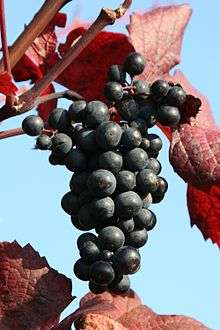Teinturier

Teinturier, a French language term meaning to dye or stain, is a wine term applied to grapes whose flesh and juice is red in colour[1] due to anthocyanin pigments accumulating within the pulp of the grape berry itself. In most cases, anthocyanin pigments are confined to the outer skin tissue only, and the squeezed grape juice of most dark-skinned grape varieties is clear. The red color of red wine comes from anthocyanins extracted from the macerated (crushed) skins, over a period of days during the fermentation process.
Wines
Teinturier varieties, while containing a lot of color, usually make special wines, perhaps due to a higher level of tannins, compounds structurally related to the anthocyanins. Many winemakers blend small volumes of teinturier juices into their wines, to boost the colour, without dramatically impacting the taste.
Examples

- Alicante Bouschet
- Alicante Ganzi
- Chambourcin
- Dunkelfelder
- Gamay de Bouze
- Grand Noir de la Calmette
- Morrastel Bouschet
- Petit Bouschet
- Royalty
- Rubired
- Salvador
- Saperavi
References
- ↑ Jancis Robinson, ed. (2006). "Teinturier". Oxford Companion to Wine (Third ed.). Oxford: Oxford University Press. pp. 688–689. ISBN 0-19-860990-6.